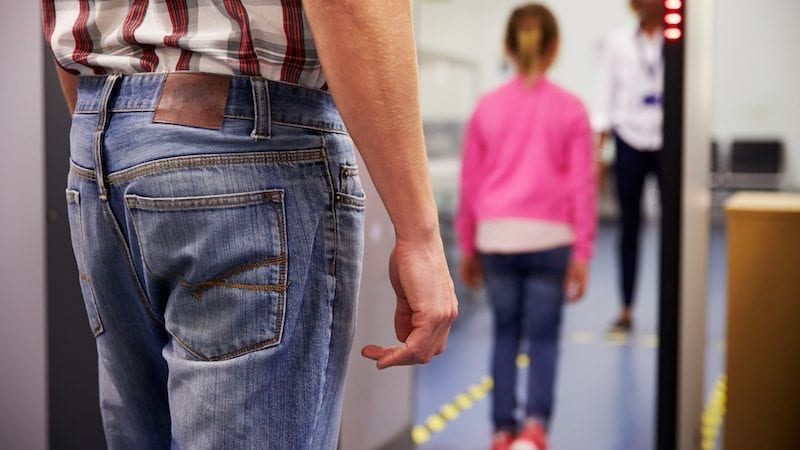My inner-city Detroit school is a fortress. Every door is locked from the outside and equipped with sensors. Leave it open too long, and the alarm screeches through the hallway. All the windows have bars and thick glass with wire mesh running through them. Only one of the six metal front doors can be opened without a pass-card or a key. None of the side doors are ever unlocked. There are cameras at every intersection and patrolling security guards. The main thruway doors have magnets that can be tripped by an alarm. They instantly shut and lock to quarantine whatever part of the building you need it to.
When you picture an ideal teaching and learning environment, this may not be it. But the reality is, if there were a shooter, he would not be able to freely roam our building.
In the wake of the most recent, devastating school shootings, educators across the country are trying to come up with new plans, new legislation, and bright ideas. Meanwhile, we inner-city educators are laying in the cut. You see, we have been abating guns in inner-city schools for the past twenty years.
A brief history of school metal detectors
These intense safety measures were introduced to Detroit schools by Dr. Robin Oden. Dr. Oden was the principal of Mumford High School from 1986–1994. During the 1989–1990 school year, he purchased and installed the first metal detectors used in a Detroit school. He is an African American man who sounds like Joe Clark, the principal from Lean On Me, when he talks. On the phone, he and I discuss his tenure as principal at Mumford.
At the time, the once-Jewish Bagley neighborhood in Detroit had experienced substantial white flight. As a result of white divestment, the neighborhood saw declining property values and the typical vices that come along with it. Dr. Oden, in no uncertain detail, recalls the day he decided to get metal detectors for Mumford. On that day, a student ran back into the school with a gunshot wound to his elbow. On his way home, he had been robbed and shot. Scared for his life, he ran to the safest place he could think of—his school.

Oden recalls a sleepless night plagued with the question: As gun violence increases out there, how can students be safe in here? Metal detectors were his solution. I was pleased to learn that bringing metal detectors into this Detroit school was a proactive choice made by someone in the school who was invested in the safety of and protecting students.
On getting searched before school
Minority-populated schools see a heavy police presence and metal detectors far more than their white counterparts—a trend which predates Columbine. Dr. Oden remembers receiving some pushback from the metal detector initiative, but the messaging was consistent and clear: Everyone would go through the metal detectors; they were for students’ safety. These procedures are now commonplace, part of the school culture, and expected.
As a result, students have a substantial sense of safety when they come to school. They have come to terms with the idea that they live in a dangerous place during dangerous times. And that it is okay to take precautionary measures against your environment. My students have shared firsthand accounts of gun violence occurring as close as the park across the street. Yet as a result of the over-policing and militarizing of inner-city school zones, there has been no reported gun violence inside the schools of Detroit—ever. An “accomplishment” reached without arming teachers.
So I walk through the metal detectors daily. Guards check my bag, and on days of heightened security, I may have to show ID. I don’t question it; I find solace in knowing the origins, in knowing that I’ll be safe while I work. In fact, when I attend an event in a suburban school, I am more jarred by the fact that I can walk right into a school and not even be greeted by a volunteer at the desk. I don’t even let alone have to buzz in to get through a locked door. Where are the precautions? Why, despite everything that has happened, is there no attempt to ease the fear?
The fight just got bigger
If you haven’t changed your mind, your bias is showing. Why is having metal detectors in inner-city schools like mine fine, but having metal detectors in suburban, better-funded schools, where shootings are happening, not? Increased and purposeful security measures are needed at all schools, regardless of the stereotypes aligned to the race of students who go there.
That is why I was so proud of my students who participated in the national school walkouts. They took to the streets, lending their voices to the movement. I asked the student organizer in my school why she chose to organize the walkout. She told me, “In our community we have been organizing and protesting against gun violence for years. One-on-one gun violence or one-on-many unarmed people is still gun violence. Just because other people are now realizing it is a problem doesn’t mean we should not participate. Actually, when you think about it, they are joining our movement.”
Welcome to the fight.
Join our Facebook group Principal Life for more conversation about and insights into the challenges of school leadership.
